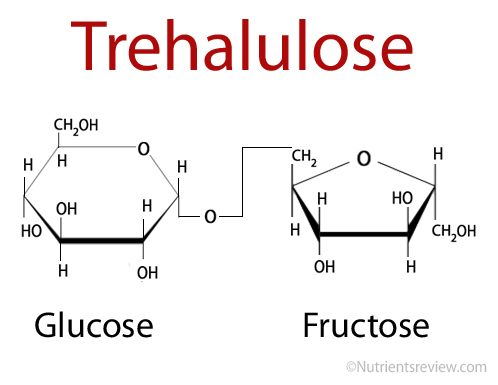- Hamada S, 2002, Role of sweeteners in the etiology and prevention of dental caries IUPAC
- Ravaud S et al, 2005, Expression, purification, crystallization and preliminary X-ray crystallographic studies of the trehalulose synthase MutB from Pseudomonas mesoacidophila MX-45 PubMed Central
- Thaweboon B et al, 2011, Fermentation of various sugars and sugar substitutes by oral microorganisms Asian Pacific Journal of Tropic Biomedicine
- Gamble GR, 2001, The heat induced degradation of melezitose and trehalulose International Cotton Advisory Committee
- 1993, Process for preparing trehalulose and isomaltulose Patent Genius
- Glucose-galactose malabsorption Genetics Home Reference
- GLUT1 deficiency syndrome Genetics Home Reference
- Rauter AP et al, 2010, Carbohydrates in Sustainable Development I
Trehalulose
What is trehalulose?
Trehalulose is an artificial sugar, a disaccharide composed of glucose and fructose joined by an alpha (1-1) glycosidic bond [1].
Trehalulose Structure
Picture 1. Trehalulose structural formula
Nutrition Facts
- Calories per gram = 4 [8-p.16]
- Sweetness relative to sucrose = 60% [1]
- Net carbohydrates = 100%
Trehalulose Sources
Trehalulose is produced during production of isomaltulose from sucrose [1].
Trehalulose Digestion
In the small intestinal lining, the enzyme isomaltase breaks trehalulose to glucose and fructose, which are then absorbed in the small intestine [1].
Trehalulose and Dental Caries
Trehalulose has a low potency to cause dental caries [1,2,3].
Who can benefit from avoiding trehalulose?
Individuals with glucose-galactose malabsorption [6] and GLUT-1 deficiency syndrome [7] can have trouble digesting trehalulose. Individuals with hereditary fructose intolerance (HFI) cannot metabolize fructose, so they should avoid trehalulose, which contains fructose.
Trehalulose and Cooking
- Trehalulose is a reducing sugar [4].
- Trehalulose is highly soluble in water [5].
Carbohydrates
- Fructose
- Galactose
- Glucose
- Isomaltose
- Isomaltulose
- Lactose
- Maltose
- Mannose
- Sucrose
- Tagatose
- Trehalose
- Trehalulose
- Xylose
- Erythritol
- Glycerol
- Hydrogenated starch hydrolysates (HSH)
- Inositol
- Isomalt
- Lactitol
- Maltitol
- Mannitol
- Sorbitol
- Xylitol
- Fructo-oligosaccharides (FOS)
- Galacto-oligosaccharides (GOS)
- Human milk oligosaccharides (HMO)
- Isomalto-oligosaccharides (IMO)
- Maltotriose
- Mannan oligosaccharides (MOS)
- Raffinose, stachyose, verbascose
- SOLUBLE FIBER:
- Acacia (arabic) gum
- Agar-agar
- Algin-alginate
- Arabynoxylan
- Beta-glucan
- Beta mannan
- Carageenan gum
- Carob or locust bean gum
- Fenugreek gum
- Galactomannans
- Gellan gum
- Glucomannan or konjac gum
- Guar gum
- Hemicellulose
- Inulin
- Karaya gum
- Pectin
- Polydextrose
- Psyllium husk mucilage
- Resistant starches
- Tara gum
- Tragacanth gum
- Xanthan gum
- INSOLUBLE FIBER:
- Cellulose
- Chitin and chitosan
- FATTY ACIDS
- Saturated
- Monounsaturated
- Polyunsaturated
- Short-chain fatty acids (SCFAs)
- Medium-chain fatty acids (MCFAs)
- Long-chain fatty acids (LCFAs)
- Very long-chain fatty acids (VLCFAs)
- Monoglycerides
- Diglycerides
- Triglycerides
- Vitamin A - Retinol and retinal
- Vitamin B1 - Thiamine
- Vitamin B2 - Riboflavin
- Vitamin B3 - Niacin
- Vitamin B5 - Pantothenic acid
- Vitamin B6 - Pyridoxine
- Vitamin B7 - Biotin
- Vitamin B9 - Folic acid
- Vitamin B12 - Cobalamin
- Choline
- Vitamin C - Ascorbic acid
- Vitamin D - Ergocalciferol and cholecalciferol
- Vitamin E - Tocopherol
- Vitamin K - Phylloquinone
- Curcumin
- FLAVONOIDS:
- Anthocyanidins
- Flavanols: Proanthocyanidins
- Flavanones: Hesperidin
- Flavonols: Quercetin
- Flavones: Diosmin, Luteolin
- Isoflavones: daidzein, genistein
- Caffeic acid
- Chlorogenic acid
- Lignans
- Resveratrol
- Tannins
- Tannic acid
- Alcohol chemical and physical properties
- Alcoholic beverages types (beer, wine, spirits)
- Denatured alcohol
- Alcohol absorption, metabolism, elimination
- Alcohol and body temperature
- Alcohol and the skin
- Alcohol, appetite and digestion
- Neurological effects of alcohol
- Alcohol, hormones and neurotransmitters
- Alcohol and pain
- Alcohol, blood pressure, heart disease and stroke
- Women, pregnancy, children and alcohol
- Alcohol tolerance
- Alcohol, blood glucose and diabetes
- Alcohol intolerance, allergy and headache
- Alcohol and psychological disorders
- Alcohol and vitamin, mineral and protein deficiency
- Alcohol-drug interactions


7 Responses to "Trehalulose"